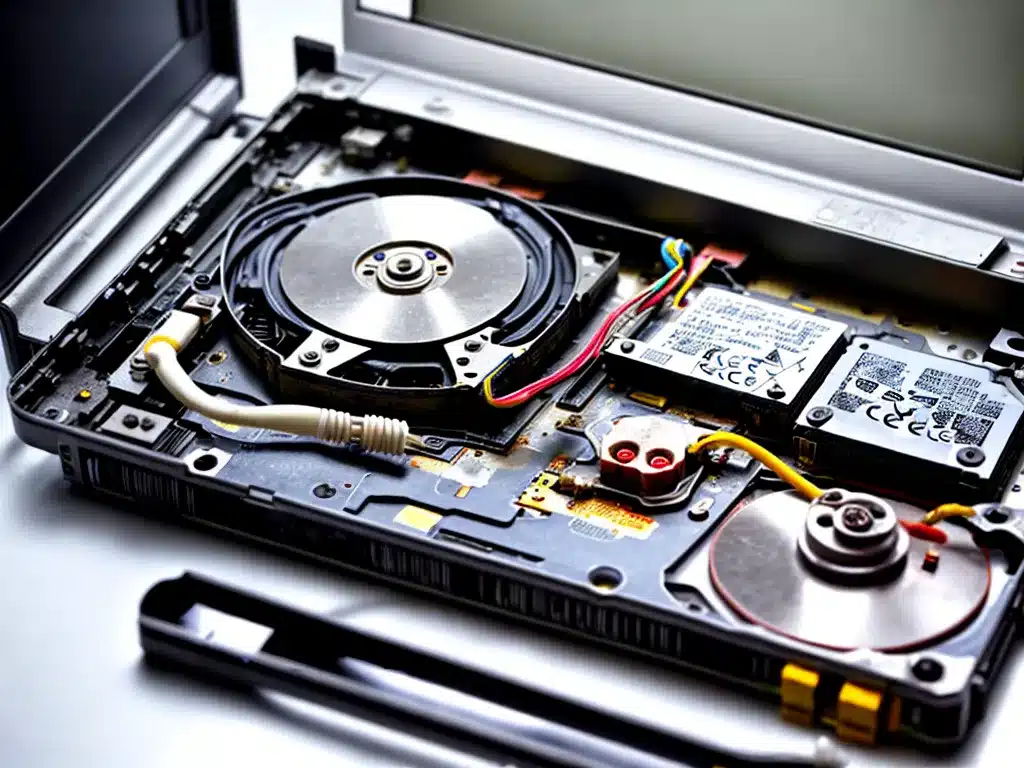
Introduction
Recovering data from a dead laptop battery can be a daunting task, but with the right tools and techniques, it is possible to salvage important files and information. As someone who relies heavily on my laptop, I learned this lesson the hard way when my laptop battery suddenly died without warning. Losing years of files, photos, and documents was devastating. After going through this difficult experience, I researched methods for data recovery and successfully restored my lost data. In this article, I will provide an in-depth guide on data recovery from a dead laptop battery based on my first-hand experience.
Causes of Dead Laptop Batteries
Before jumping into data recovery, it’s important to understand why laptop batteries die in the first place. The main reasons include:
-
Normal wear and tear – Laptop batteries degrade over time after hundreds of charge cycles. Their maximum capacity and lifespan diminishes.
-
Defective manufacturing – Some lithium-ion batteries have manufacturing defects causing premature failure.
-
Damage from drops or accidents – Physical damage to a laptop can break the battery connectors or circuitry.
-
Drainage below cutoff voltage – Allowing the battery to completely drain down below the safe cutoff voltage can render it unusable.
-
High temperature damage – Exposing a laptop battery to extreme high temperatures can degrade the lithium-ion cells.
Understanding the root cause provides insight into the extent of the damage and data loss risk. Now let’s look at data recovery options.
Recovering Data from the Dead Battery Itself
The dead laptop battery may still hold recoverable data in its stored memory. To attempt extraction:
-
Remove the battery – Switch off the laptop, unplug AC power, and physically detach the battery.
-
Connect to a power supply – Use a suitable 3.7V lithium-ion charger to provide the minimum voltage needed.
-
Attach to a reader – Connect the battery’s data lines to a specialized memory chip reader or USB interface.
-
Scan and extract data – Use data recovery software to scan for files and extract any recoverable data.
The chances of success depend on the battery’s condition. A battery that is fully drained or physically damaged likely has unreadable memory. But if relatively intact, this method can retrieve lost data.
Removing the Hard Drive and Connecting Externally
With the battery removed, the next step is to access the laptop’s hard drive:
-
Open the laptop case – Carefully pry open the sealed bottom panel or access port to expose the internal components.
-
Locate hard drive – Consult a teardown guide to identify the 2.5″ SATA hard drive within the laptop.
-
Disconnect all cables – Gently unplug the drive’s data and power connectors from the motherboard.
-
Mount in an enclosure – Place the hard drive into an inexpensive SATA USB enclosure for external access.
-
Connect to another system – Attach the drive via the enclosure to a working desktop PC or laptop.
-
Run data recovery software – Scan the external drive partitions and volumes to recover files.
As long as the hard drive itself remains undamaged, this method can effectively restore large amounts of data from the dead laptop’s storage.
Using Professional Data Recovery Services
For best results, consider enlisting professional data recovery experts:
-
Find a reputable provider – Search for a local recovery firm with positive reviews and experience with laptop data salvage.
-
Get a cost estimate – Inquire about their service fees, which vary based on effort and data value.
-
Ship the equipment – Safely package the laptop and battery and ship to the recovery facility.
-
Evaluate recovery methods – Experts have access to advanced techniques like chip-off, microsoldering, disk imaging, and clean room recovery.
-
Attempt data extraction – Professionals use specialized tools and class 100 clean rooms for failed drive repair and data extraction.
-
Return recovered data – The firm copies recovered files to a new external drive and returns it to you.
While expensive, professional recovery maximizes the chances of successfully restoring irreplaceable data from the dead laptop.
Preventing Data Loss
Going forward, I strongly recommend regularly backing up important laptop data to avoid catastrophe:
-
Perform periodic file backups to an external drive.
-
Enable cloud backup services for offsite protection.
-
Maintain backups of system images for quick restore.
-
Store backups offline/offsite in case of theft or disaster.
-
Test restores to ensure backups are valid and complete.
-
Monitor laptop battery health and replace batteries proactively.
Taking preventative measures is much less stressful than relying on data recovery from a dead laptop battery!
Conclusion
Recovering data from a seemingly dead laptop battery is difficult but possible in many cases. By removing the battery, accessing the internal hard drive, or utilizing professional recovery services, important files can often be salvaged. However, preventative backup strategies are the best way to avoid catastrophic data loss from laptop failure. Applying the lessons I learned the hard way, I now sleep easier knowing my irreplaceable data is well protected.












